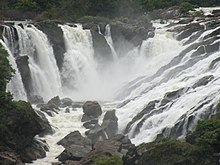
India is 5th globally for installed hydroelectric power capacity.[1] As of 31 March 2020, India's installed utility-scale hydroelectric capacity was 46,000 MW, or 12.3% of its total utility power generation capacity.[2] Additional smaller hydroelectric power units with a total capacity of 4,683 MW (1.3% of its total utility power generation capacity) have been installed.[3] India's hydroelectric power potential is estimated at 148,700 MW at 60% load factor.[4] In the fiscal year 2019–20, the total hydroelectric power generated in India was 156 TWh (excluding small hydro) with an average capacity factor of 38.71%.
The hydroelectric power plants at Darjeeling and Shivanasamudra were established in 1898 and 1902, respectively. They were among the first in Asia and India has been a dominant player in global hydroelectric power development.[5] India also imports surplus hydroelectric power from Bhutan.
Small hydropower, defined to be generated at facilities with nameplate capacities up to 25 MW, comes under the ambit of the Ministry of New and Renewable energy (MNRE); whilst large hydro, defined as above 25 MW, comes under the ambit of the Ministry of Power.[6][7] Koyna Hydroelectric Project is the largest completed hydroelectric power plant in India, with a power capacity of 1960 MW
India's hydroelectric power output dropped by 16.3% in the fiscal year ending March 31, 2024, the largest decline in 38 years, primarily due to low rainfall. This decrease led to hydroelectricity's share of India's total power generation falling to a historic low of 8.3%. As a result, the country's reliance on coal increased, with hydro generation reaching a five-year low of 146 billion kWh. The lack of rainfall was attributed to the lightest rainfall since 2018 and potentially influenced by the El Niño weather pattern. Consequently, hydroelectric power's role in the Indian energy mix is diminishing, with its reliability questioned due to erratic weather patterns.[8]
- ^ "India overtakes Japan with fifth-largest hydropower capacity in the world". Retrieved 30 May 2020.
- ^ "All India installed capacity of power stations, March 2020" (PDF). Archived from the original (PDF) on 12 May 2020. Retrieved 25 May 2020.
- ^ "Renewable Energy Physical Progress as on 31-03-2020". Ministry of New & Renewable Energy, GoI. Retrieved 4 June 2020.
- ^ "Hydro Electric Potential in India". Archived from the original on 26 August 2018. Retrieved 17 April 2016.
- ^ "India remains major competitor in global hydropower". Archived from the original on 16 April 2016. Retrieved 17 April 2016.
- ^ "Executive Summary Power Sector February 2017" (PDF). report. Central Electricity Authority, Ministry of Power, Govt. of India. 28 February 2017. Archived from the original (pdf) on 17 April 2018. Retrieved 24 April 2017.
- ^ "Small Hydro". Government of India Ministry of New and Renewable Energy. Archived from the original on 2018-02-20. Retrieved 6 April 2019.
- ^ Varadhan, Sudarshan; Yap, Cassandra (2024-04-01). "India hydropower output records steepest fall in nearly four decades". Reuters. Retrieved 2024-04-03.